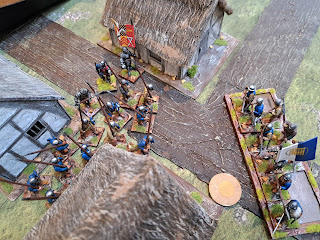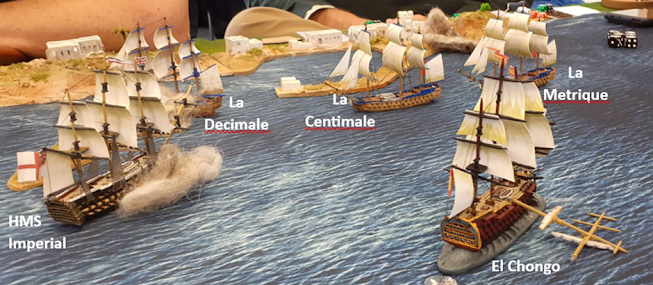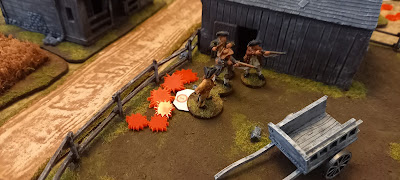We wanted a nice quick, simple 3-way game, so I dusted off the Lion Rampant 2 rules. Having sufficient Wars of the Roses figures to create three 24 point forces, this was the selected period. The aim of the game was to search the village, to locate the missing documentation which would prove the legitimacy / illegitimacy of the current king. Once a unit contacted a building, a ‘Move’ action would search the building and reveal whether the documentation was there. Three buildings to search, with one set of documentation. The forces were;
Force A – Dave (Entering middle of North table edge),
- Elite Cavalry (Knights) - 6 points
- 2x Veteran Heavy Infantry (Billmen) – 12 pts
- Veteran Archer – 6 points
Force B – Steve (Entering South East Corner),
- Elite Infantry (Foot Knights) - 6 points
- Heavy Cavalry (Hoblier) - 4 points
- Veteran Heavy Infantry (Billmen) – 6 pts
- Veteran Archer – 6 points
- Skirmishers (Crossbowmen) – 2 points
Force C – Mal (Entering South West corner),
- Elite Infantry (Foot Knights) - 6 points
- Veteran Heavy Infantry (Billmen) – 6 pts
- Heavy Infantry (Spearmen) – 4 points
- Veteran Archer – 6 points
- Skirmishers (Handgunners) – 2 points
Dave had first choice of force, with Mal second & Steve last. Selection of entry point was then in reverse order.
Dave opened with a nice orderly march down from the North. Mal’s forces marched up from the South West, with a little bit more disorder, as his archers were dragging their heels, mumbling something about some tight Northern git not paying them! Steve’s Hobliers made an immediate dash for Dave’s archers, while his lord & attendant knights made a quick dash for the village.
Dave suddenly realised that the Wild Charge characteristic of his knights could quickly result in them single-handedly charging the entirety of Mal’s force, so they re-deployed toward the left flank, thereby heading off Steve’s Hobliers.
Dave’s archers decided to save their arrows and so Steve’s hobliers mounted a frontal charge. Disaster! Some rather crappy dice rolling resulted in Steve’s hobliers being thrown back in a 2-all draw.
Dave’s knights now thundered into the fray, met by a furious counter charge by Steve’s surviving hobliers. A crashing of horse and lance resulted in another 2-all draw, and Dave’s knights thrown back. However, Dave had his archers ready and they thinned the hobliers ranks down to a stubborn last man.
However, Steve still had a plan! His last Hoblier lured Dave’s knights into another Wild Charge, eliminating the last of Steve’s cavalry, but also placing Dave’s knights in a position where they would unwisely charge Steve’s skirmishers, hiding in the woods!
Meanwhile, back in the village, Dave’s men and Mal’s men had turn-over two of the houses an found nothing. Steve’s foot knights however had struck gold in the last hut. But no sooner had they unrolled the vital parchments, then Mal’s foot knights lumbered around the corner. Red mist descending, Steve’s knights charged and after a brutal street fight, Steve’s knights were thrown back, leaving the parchments scattered in the street. Worse still, his lord was killed in the clash!
Dave’s Billmen then attempted to muscle-in to grab the parchments, but after clashing with Mal’s knights, both sides pulled back, glaring at each other, over the pile of documentation.
But by this time, Mal’s spearmen had filtered into the South of the village, and took over the stand-off with Dave’s Billmen. At the same time, Mal’s archers worked around the South of the village and started to shower arrows on Steve miserable survivors.
Into the middle of this, Dave’s two surviving mounted knights careered about, charging stuff at random. But, just as they stopped to look for new targets, a hail of arrows from Mal’s Longbowmen cut short the life of Dave’s last knight & force commander!
Dave’s Billmen could not take this insult and charged the spearmen, only to be thrown back, ‘battered’ for their troubles!
At this point, Mal’s spearmen snatched up the vital parchments and marched Westward, while his lord made rude gestures to the survivors of Steve’s and Dave’s forces! A classic case of ‘slow & steady wins the race’!
Time maybe to introduce some Leader Skills and maybe even try to merge Dragon Rampant, to give the old Song of Ice & Fire miniatures some table time?!















.jpg)

















































